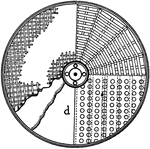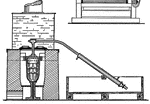Gold Extraction
The Gold Extraction ClipArt gallery offers 5 illustrations showing the process of extracting and refining gold from gold ore.

Chlorination Barrel (End Section)
The chlorination process in gold extraction employs large vats or revolving barrels, the material inside…

Cyanide Leaching Tank (Gold Extraction)
In the gold extraction process, finely crushed ores are leached in vats with a very diluted solution…

Frue Vanner (Side View)
A Frue Vanner is a shaking, rubber belt used to concentrate gold ore 'pulp'.

Retort Furnace for Gold Bullion
This furnace is used to purify a gold concentrate. The gold concentrates, if non-pyritic, are treated…
